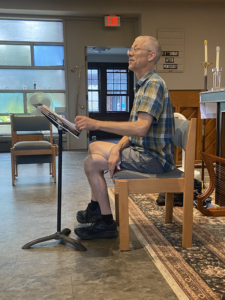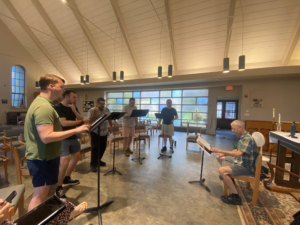
 Today we spent our entire morning working on Johannes Okeghem’s Missa Caput, a piece we first performed as part of Blue Heron’s complete cycle Ockeghem@600, back in 2017. (We were still spelling his name “Ockeghem” back then. That’s one of the ways it was spelled in the 15th century, but recently a signature of his has been rediscovered which appears to read “J. de Okeghem,” so we’ve switched to OKEGHEM.) The Missa Caput is one of his very earliest pieces, and very challenging and mysterious it is—in that way highly characteristic of this most searching and inventive composer, who seems to have posed himself a new problem to solve in each one of his dozen Masses.
Today we spent our entire morning working on Johannes Okeghem’s Missa Caput, a piece we first performed as part of Blue Heron’s complete cycle Ockeghem@600, back in 2017. (We were still spelling his name “Ockeghem” back then. That’s one of the ways it was spelled in the 15th century, but recently a signature of his has been rediscovered which appears to read “J. de Okeghem,” so we’ve switched to OKEGHEM.) The Missa Caput is one of his very earliest pieces, and very challenging and mysterious it is—in that way highly characteristic of this most searching and inventive composer, who seems to have posed himself a new problem to solve in each one of his dozen Masses.
Here the problem is this: Take the tenor part of an anonymous English Mass—also called the Missa Caput, of course, and perhaps the most famous of a wave of English Masses that arrived on the European continent in the 1440 by way of trading ports and artistic centers like Antwerp. That tenor part is a cantus firmus, a pre-existent melody, the notes of which are taken from a melisma in a piece of plainchant from the English Sarum rite setting the word caput. Now, Okeghem didn’t know the plainchant itself—he wouldn’t have known the Sarum tradition—so what he takes is the tenor part of the polyphonic English Mass, with all the rhythms chosen by the English composer for his piece.
 So far, already unusual, but here’s where it really gets weird: now Okeghem takes that tenor part and instructs the singers, by way of a verbal cue: “Take this Caput and sing it down an octave.” With that the tenor becomes the lowest of the four voice parts, rather than second from lowest, the usual tenor position. Curiouser and curiouser: the plainchant melisma that became the Mass tenor is in G, with lots of B naturals, some of which will now need F sharps above them—but Okeghem’s Mass is in D, with lots of F naturals, and occasional B-flats, too. In short, the cantus firmus and the piece in which it is used are in two different modes—two different keys! And because 15th-century musicians frequently didn’t specify flats and sharps, but relied on the singers to know how to apply harmonic and melodic principles to decide, nowadays we aren’t always sure what the composer wanted. A puzzle!
So far, already unusual, but here’s where it really gets weird: now Okeghem takes that tenor part and instructs the singers, by way of a verbal cue: “Take this Caput and sing it down an octave.” With that the tenor becomes the lowest of the four voice parts, rather than second from lowest, the usual tenor position. Curiouser and curiouser: the plainchant melisma that became the Mass tenor is in G, with lots of B naturals, some of which will now need F sharps above them—but Okeghem’s Mass is in D, with lots of F naturals, and occasional B-flats, too. In short, the cantus firmus and the piece in which it is used are in two different modes—two different keys! And because 15th-century musicians frequently didn’t specify flats and sharps, but relied on the singers to know how to apply harmonic and melodic principles to decide, nowadays we aren’t always sure what the composer wanted. A puzzle!
The result, however, no matter how we solve those questions of accidentals, is a piece that sounds like no other. But—it’s Okeghem, after all—it turns out to be very beautiful, too, full of wonder and sensuous delight, as well as intellectual rigor and formidable technique.


